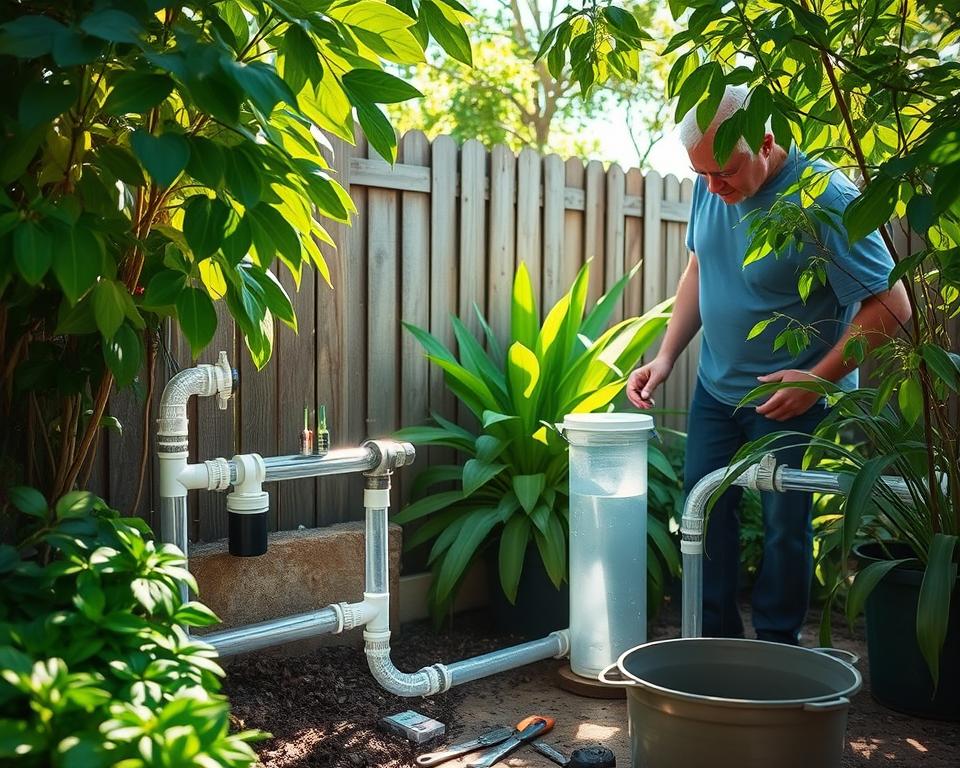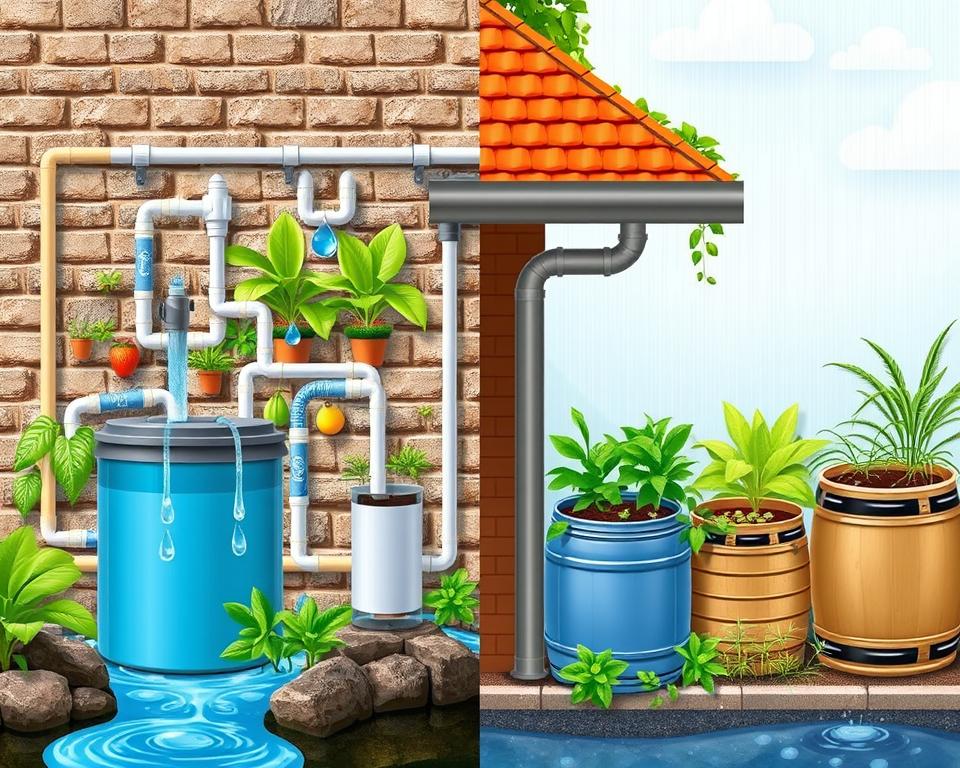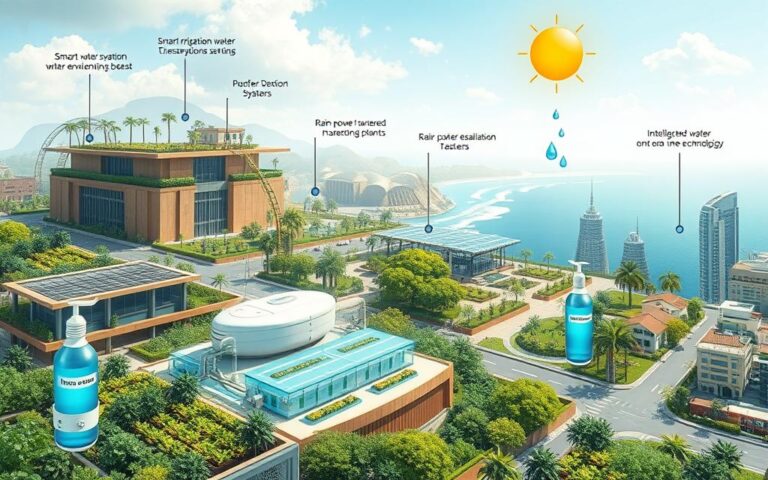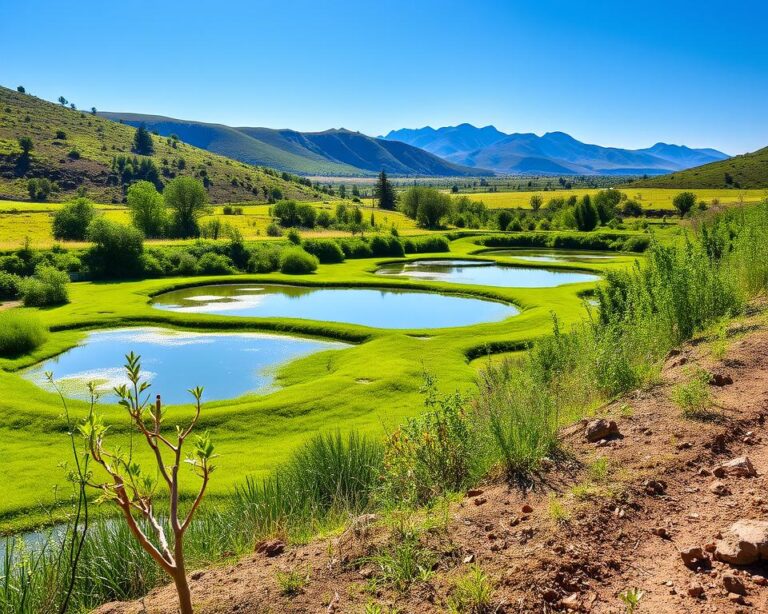Did you know the average American uses 82 gallons of water daily? Almost one-third of that is for watering plants. This adds up to nearly 8 billion gallons per day across the U.S.!
Finding ways to use water more wisely is key. Greywater systems can recycle water from laundry, showers, and sinks. This saves resources and lowers your water bills.
Greywater is water that’s been used but not contaminated with feces. It’s full of nutrients, making it great for residential water recycling. These systems can save up to 40,000 gallons of water each year. They also feed plants, making them healthier.
In this guide, we’ll dive into how greywater systems work. You’ll learn how to use them to manage water better and sustainably.
What Are Greywater Systems?
Greywater systems are key to saving water. They use water from sinks, showers, and washing machines. This water is safe to reuse, unlike water from toilets.
By using greywater, homes can save a lot of water. This helps the environment and saves money on water bills.
Definition of Greywater
The greywater definition is water used for daily tasks like washing and bathing. It’s different from blackwater, which is not safe to reuse. A person can make about 30 gallons of greywater each day.
This water is good for irrigation and other uses. It’s a big help for saving water.
Types of Greywater
There are many types of greywater. Each type has its own characteristics and nutrients. Here are the main sources:
- Bathwater and Shower Water: This water is full of soap and organic matter. It makes up 42-79% of household greywater.
- Laundry Water: This water has detergents and softeners. It’s 5-23% of greywater.
- Kitchen Sink Water: This water has fats and food debris. It’s 10-17% of greywater.
- Bathroom Sink Water: This water has personal care products. It’s 5-6% of greywater.
Importance of Greywater Systems
Greywater systems are very important. They help reduce the load on sewage systems and save fresh water. As cities grow, water shortages will become more common.
Using greywater recycling is a smart solution. It saves water and money on bills. It also makes plants healthier and saves water for the future.
| Type of Greywater | Source | Percentage of Total Greywater | Characteristics |
|---|---|---|---|
| Bathwater/Shower Water | Bathtub/Shower | 42-79% | Rich in soap and organic matter |
| Laundry Water | Washing Machine | 5-23% | Contains detergents and softeners |
| Kitchen Sink Water | Kitchen Sink/Dishwasher | 10-17% | Higher in fats and food debris |
| Bathroom Sink Water | Bathroom Sink | 5-6% | Contains personal care products |
Benefits of Using Greywater Systems
Greywater systems bring big wins for both your wallet and the planet. They let you reuse water from your home, saving money and water. Plus, they make your garden and yard look great.
Environmental Impact
Greywater systems can save up to 40,000 gallons of water a year. This helps keep local water sources full. It also means less fresh water is used for irrigation, helping the environment.
Greywater is full of nutrients that plants love. This makes it a natural fertilizer, adding to its green benefits.
Cost Savings
Using greywater can cut your water bills, especially in summer. It means you use less municipal water, saving money. Over time, these savings can add up, helping with other household costs.
It also helps your septic system last longer. This can save you from expensive repairs or replacements.
Enhancing Landscape Health
Greywater keeps your plants watered consistently. This is especially true with drip irrigation. It gives plants steady food.
Systems like Aqua2use let a bit of soap in the water. This helps the soil and plants even more. Using greywater in your garden improves soil quality and adds nutrients, making your yard healthier.
| Benefit | Description | Impact |
|---|---|---|
| Water Conservation | Saves up to 40,000 gallons of water annually | Supports local water supply sustainability |
| Cost Reduction | Lower water bills through reduced consumption | Economical savings for households |
| Soil Enrichment | Provides essential nutrients to plants | Enhances garden and landscape health |
How to Install a Greywater System
Installing greywater systems can make your home more water-efficient. First, you need to check your home’s plumbing to find good sources of greywater. Greywater is wastewater from sinks, showers, and washing machines, but not kitchen sinks or dishwashers. Knowing this helps you set up your system right.
Assessing Your Home’s Plumbing
Begin by looking at your plumbing setup. Look at:
- Which fixtures produce greywater, like bathtubs and washing machines.
- If you need to change your plumbing to use greywater.
- The distance between greywater sources and where you’ll use it.
This helps you see how you can use greywater well and follow local rules.
Step-by-Step Installation Process
After assessing, start installing. Here’s how:
- Pick the right greywater system for you, like laundry-to-landscape.
- Put in diverters and pipes from greywater sources to irrigation areas.
- Choose the best way to water your plants, based on what they need.
- Ensure all connections are tight to avoid leaks.
These steps are a basic guide for setting up a greywater system. More complex systems might need permits.
Local Regulations and Permits
Know your area’s greywater rules before you start. Rules can differ a lot and might include:
- How deep irrigation lines must be
- How far from property lines you can be
- Permits needed for bigger systems
In San Diego County, there are rules for both unincorporated areas and cities. Following these rules makes sure your system works well and doesn’t harm water sources.
Types of Greywater Systems Available
When looking at greywater systems, it’s key to know the different types. Each type meets different needs and has its own benefits. This section will look at simple diverter systems, full greywater treatment systems, and hybrid systems. This will help you choose the best one for your home.
Simple Diverter Systems
Simple diverter systems are easy to set up. They need little plumbing work. These systems send greywater from sinks and showers to your garden.
They must meet WaterMark standards for safety. In many places, you can only use them for underground irrigation. This saves water and keeps plants healthy.
Full Greywater Treatment Systems
Full greywater treatment systems clean the water more thoroughly. They make it safe for flushing toilets, irrigation, and washing machines. The AQUALOOP system, for example, is certified for both small and big uses.
It’s important to keep these systems in good shape. Untreated systems can fail over time.
Hybrid Greywater Systems
Hybrid systems mix features of diverter and treatment systems. They offer flexibility for your home. These systems are good for those who want to reuse water but also want simplicity.
They often have self-cleaning filters. This reduces the chance of mechanical failure.
| System Type | Key Features | Usage Options | Maintenance Needs |
|---|---|---|---|
| Simple Diverter Systems | Minimal plumbing changes | Subsurface irrigation | Low |
| Full Treatment Systems | Advanced purification processes | Surface irrigation, toilet flushing, washing machine | Moderate to high |
| Hybrid Systems | Combined features of diverter and treatment systems | Adaptable usage options | Varies based on configuration |
Picking the right greywater system is important for saving water. Think about your home’s needs and look at the options. This will help you find the best system for you.
Identifying Sources of Greywater in Your Home
Knowing where greywater comes from in your home can help save water. By using laundry and shower water wisely, you can cut down on water use and bills. Let’s explore the main greywater sources in homes.
Laundry Water
Laundry water is a big source of greywater. Washing machines use a lot of water that can be reused for plants or other non-drinking needs. This saves fresh water and helps the planet.
Many people choose systems to catch and use this water. It’s a smart move for saving water and money.
Shower and Bath Water
Shower water is another great source for reuse. Water from baths and showers can be used for plants. It’s cleaner than kitchen water, making it safer for gardens.
With the right system, you can use this water to feed your plants. It’s a natural way to reduce the need for chemical fertilizers.
Kitchen Sink Water
Kitchen sink water is a greywater source, but it’s tricky. It has food bits and grease that can block systems. Some systems have filters to handle this, but others advise against using it.
In some places, kitchen water is called blackwater. It needs special handling. But, with the right precautions, kitchen water can be used safely.
| Source | Advantages | Considerations |
|---|---|---|
| Laundry Water | High volume and easy to divert | Minimal contaminants, safe for irrigation |
| Shower and Bath Water | Rich in nutrients, improves plant health | Requires treatment for safety |
| Kitchen Sink Water | Convenient source | High in organic matter, may clog systems |
Maintenance Tips for Greywater Systems
Keeping your greywater system in top shape is key to its success. Regular upkeep stops problems before they start. Here are some tips to keep your system working well.
Regular Inspections
Regularly check your greywater system for any issues. Look for wear and tear, and make sure everything is working right. This can save you from expensive fixes later on.
Cleaning Filters and Pipes
Keep your system’s filters and pipes clean to avoid blockages. Regular cleaning helps water flow smoothly. It’s crucial for your system’s performance.
Troubleshooting Common Issues
Knowing how to fix common problems can save you time. If you notice odd smells or backups, act fast. Quick action helps avoid bigger problems with greywater reuse.

| Maintenance Tip | Description | Frequency |
|---|---|---|
| Inspection | Check for wear, damage, and overall system function. | Every 6 months |
| Filter Cleaning | Clean filters to prevent blockages. | Every 3 months |
| Pipe Maintenance | Flush pipes to clear debris and ensure optimal flow. | Every 6 months |
| Troubleshooting | Address any odors or backups immediately. | As needed |
Following these maintenance tips boosts your system’s performance. It also protects your investment in greywater reuse. Good maintenance makes your system more efficient and supports sustainable water use at home.
Choosing the Right Greywater System for You
Choosing the right greywater system is important. Each home has different needs based on water use and garden size. You should think about how much greywater you have, your garden’s size, and the plants you want to water.
Factors to Consider
There are key things to keep in mind when picking a system:
- Volume of Greywater: Figure out how much greywater your home uses. A family can save about 2,600 gallons a year with a good system.
- Garden and Landscape: Think about your garden’s size and type. Some systems work better for bigger or specific plants.
- Simplicity and Cost: If you’re on a tight budget, consider simple, cheap systems like diversion-only ones.
Comparing System Types
Looking at different systems can help you choose the best one for your home:
| System Type | Description | Cost | Maintenance |
|---|---|---|---|
| Diversion Only | Simple setup directing greywater to the garden | Low | Minimal, regular checks needed |
| Diversion and Filtration | Includes filtration to remove particles like hair | Medium | Periodic filter cleaning required |
| Diversion and Treatment | Advanced systems treating greywater for broader use | High | Frequent maintenance and checks |
Budgeting for Your Greywater System
Planning your budget for a greywater system is key:
- DIY Options: Look into simple, DIY systems like diversion-only ones to save money.
- Professional Installation: More complex systems might need a pro, which can cost more.
- Long-Term Savings: A greywater system can cut your water bills by a lot, saving up to 40,000 gallons a year.
Common Misconceptions About Greywater
Many people think greywater systems are not safe or too complicated. But, understanding greywater can help you use it safely and effectively. This is key for using greywater systems well.
Safety Concerns
Some worry greywater might be harmful. But, with the right setup, greywater is safe for irrigation and other uses. Using the right filters makes greywater safe, letting you reuse it without health risks.
Permitting Myths
Many think getting permits for greywater systems is hard. But, most places just need some paperwork and following rules. Knowing how to get permits makes setting up a greywater system easier.
Usage Limitations
Some think greywater can only be used in certain ways. But, it’s really versatile, especially for watering plants. Seeing greywater’s full potential can make your home more sustainable.
| Misperception | Reality |
|---|---|
| Greywater is unsafe for use | Proper handling ensures safety for irrigation and other applications |
| Permitting is overly complicated | Most areas require basic documentation, not outright bans |
| Usage is highly limited | Greywater can be adapted for multiple non-potable uses |
Greywater vs. Rainwater Harvesting
When looking at ways to save water, you might wonder about greywater vs. rainwater harvesting. Both are key to saving our planet, but they collect water in different ways. Knowing how they work can help you choose the right one for your place.
Similarities and Differences
Both greywater and rainwater systems aim to cut down water use and help the environment. Greywater uses water from showers, sinks, and laundry for other tasks. Rainwater, on the other hand, collects rain for when you need it.
Greywater can be up to 80% of your home’s wastewater. Rainwater, however, is pure water from the sky.
Advantages of Each System
Greywater is great for saving money and water. It’s easy to set up and doesn’t need big tanks or pumps. Rainwater, though, is cleaner and can be used for more things, like drinking water, if allowed by law.
It’s like getting free water that would otherwise flow away.
Choosing a Suitable Option
What you choose depends on your needs and where you live. Greywater is good for watering plants and saving money. Rainwater is better for places with little rain and more storage needs.
Think about your situation to pick the best water-saving method for you.

Case Studies: Successful Greywater Implementation
Looking at successful greywater projects gives us valuable insights. These systems work well in homes and communities. We’ll talk about successes in homes, big community projects, and what we’ve learned.
Residential Success Stories
Greywater systems in homes are saving a lot of water. For example, the AdvanTex AX-Max unit handles 2,660 gallons a day. This means homes can use up to 30% less water for flushing toilets.
People are saving about 16.6 liters of water each day. This is a big win for any home.
Community Projects
Big community projects show how working together can save a lot of water. The Cedar Springs Apartments have a greywater system that works well. It can handle up to 3,000 gallons a day.
These projects help save water and teach people about being green. It’s a team effort towards a sustainable future.
Lessons Learned
Greywater systems are becoming more common, and we’re learning a lot. One big challenge is keeping the system up and the cost, which can be from $200 to $4,000. It’s also important to know how it saves energy and chemicals.
Getting people involved and educated is key. Programs like the Residential Greywater Series by Sani Water help a lot. They make sure these systems work well for a long time.
| Aspect | Residential Examples | Community Projects |
|---|---|---|
| Water Savings | Up to 30% reduction in household use | Alleviation of community water consumption |
| System Cost | Ranges from $200 to $4,000 | Large-scale systems can equalize costs |
| Daily Flow Capacity | AdvanTex AX-Max: 2,660 gallons | Cedar Springs: 3,000 gallons peak flow |
| Main Benefits | Reduction in chemical and energy usage | Community engagement in sustainability |
Future Trends in Greywater Systems
The future of greywater systems is looking bright. New technologies like Membrane Bioreactors (MBRs) and smart water management systems are leading the way. These advancements will make greywater systems more efficient and accessible for everyone.
Technological Innovations
Greywater systems are evolving, thanks to policy changes that support their use. Sustainable water management is becoming a priority, leading to updated guidelines. The Laundry to Landscape system is a great example of how simple technology can save water.
Policy Changes
Community involvement is key in spreading the word about greywater systems. Educational efforts are helping people understand their benefits. This knowledge can encourage more people to use greywater systems in their homes.
Increasing Popularity and Awareness
More and more people are showing interest in greywater systems. This growing interest is reflected in the views on articles and discussions about them. As awareness grows, greywater systems will become a common part of water conservation efforts.




